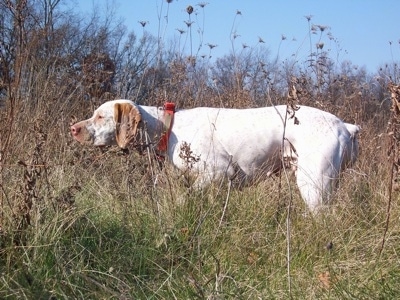
Photo courtesy of Rufnit Kennels
brahk do boor-bon-NAY
The Braque du Bourbonnais is an elegant, shorthaired, muscular, medium-sized pointing dog. Head: Rounded in every direction. The axes of the skull and muzzle are parallel, or slightly divergent toward the front. The stop is slightly marked. Facial region: Nose is the same color as the coat, nostrils well open. Muzzle is strong and wide at its base; truncated cone in shape. Bridge of the nose is straight or very slightly convex. Upper lips hiding lower lips, not too thick. Eyes are big; hazel or dark amber in color, according to the color of the coat. Ears are set at eye-line level or slightly above and may extend slightly below the throat in their natural position. Neck: Muscled and solidly set into the shoulders. Body: Withers are muscular and protruding. Slight convexity at loin level. Short, solid, wide and muscular, very firm. Chest is wide, long and deep, reaching or extending slightly below the level of the elbow. The Braque du Bourbonnais has well-sprung and rounded ribs. Its underline is slightly raised toward the back; flanks are flat and slightly raised. Tail: Set rather low; short or naturally absent. Limbs: Forequarters are straight, well-constructed and muscular. Shoulders are oblique, strong and long with apparent musculature. Feet have lean pads with tight and arched toes. Hindquarters have good bone structure with very apparent muscular masses. A vertical line from the point of the buttock falls in front of the point of the hock. Stifle is well angulated. Coat: Fine, short and dense hair. The hair may be a little coarser and sometimes a little longer on the back. The two colors are liver and fawn. They are strongly to moderately ticked, with possible spotting. The same spot should not cover both eyes.
The Braque du Bourbonnais is a calm, affectionate family companion. When hunting they are full of passion, cautious, balanced, cooperative and intelligent. They have a remarkable ease of adaptation to the most varied terrains and game. This intense pointing dog has an ability to train easily and quickly. They are people-oriented and not happy if isolated from the family. They need human leadership. Owners must be firm, confident and consistent with the rules. When exercised sufficiently, at least once a day, they make a very agreeable family companion. The Braque du Bourbonnais typically gets along with all other canines.
Weight: Males 39.5 - 55 pounds (18 - 25 kg) Females 35 - 48.5 pounds (16 - 22 kg)
Height: Males 20 - 22.5 inches (51 - 57 cm) Females 18.5 - 22 inches (47 - 56 cm)
This breed is typically healthy. A couple health concerns that have appeared sparingly are: hip dysplasia, entropion or ectropion eyes and pulmonic stenosis of the heart.
The Braque du Bourbonnais is not recommended for apartment life. This breed does best with a large yard and hunting family. These dogs need daily exercise. Due to this breed being people-oriented, they prefer to reside in the home with its owner and family, rather than be kenneled outside.
Daily exercise is important, which includes a long daily walk, where the dog is made to heel beside or behind the human. Never in front, as in the dog's mind, pack leader goes first. This breed is bred to hunt, so it prefers an active outdoor life. Without family companionship and daily exercise, it can become destructive or depressed.
About 13-15 years
About 3 to 6 puppies
These dogs are wrapped up in a medium-sized package that is easily maintained with their short, minimal shedding, “wash-and-wear” coats. As with all breeds, ear cleaning, nail clipping and bathing should be done when necessary.
The Braque du Bourbonnais originated in the Province of Bourbonnais, France. This breed can be traced back as far as 1598. The breeders, for a long time, wanted to impose that the puppies being born had to naturally have a short tail. Due to the reduced gene pool, such a strict selection on secondary points resulted in no registrations between 1963 and 1973. In 1970 a team of breeders gave themselves the task of helping the survival of the Braque du Bourbonnais. Thanks to a careful and effective selection, they have succeeded.
Gun Dog, Sporting

"The picture is of KC; we were training her at our NAVHDA training grounds in Highland, Michigan. Braque du Bourbonnais (French Pointing Dog), photo courtesy of Aspen Ridge Braque du Bourbonnais"
Brauqes are a medium-size hunting dog, with a great desire not only to hunt but to please you. They have an "on/off" switch like no other hunting dog that I have seen. The minute you release them in the field the hunting switch is flipped "on". When you get them home they flip that switch "off" and they are just as content to sit on the couch with you and watch a movie. They have a short, dense coat that dries in minutes and is easy to groom. Bourbonnais have a sweet personality and have a very soft temperament—they do not need a lot of corrections to train; you will get further with a soft voice and hand than you will with a firm voice and a heavy hand. While softer dogs are wonderful around the home they often take a little longer to train for hunting, but is well worth the time you put into them. While they are a hunting dog and like to run, a daily walk is fine for them."